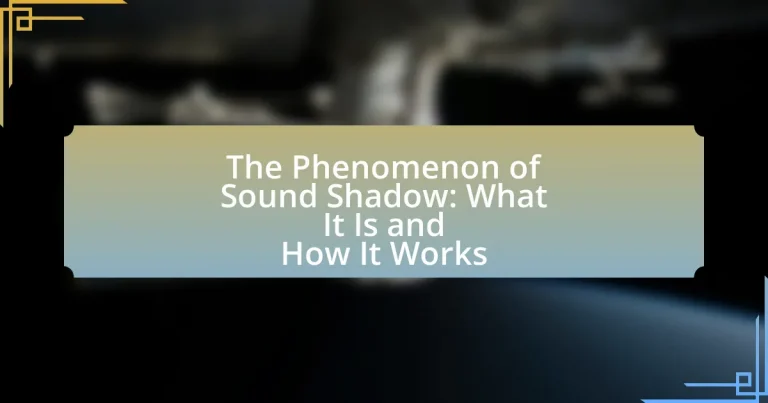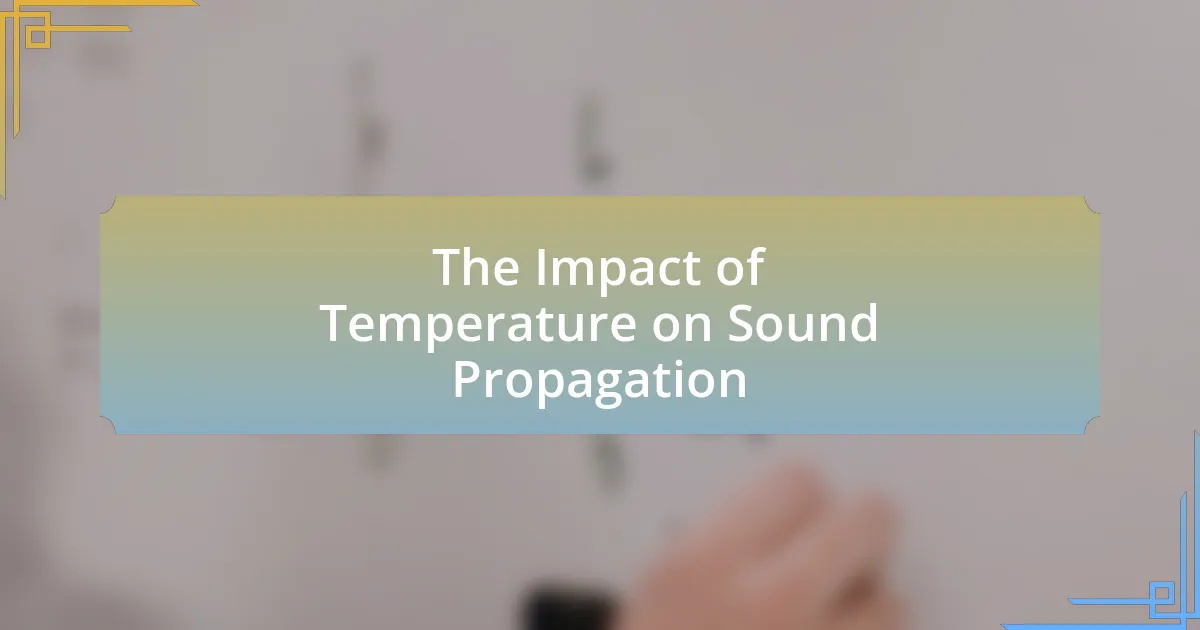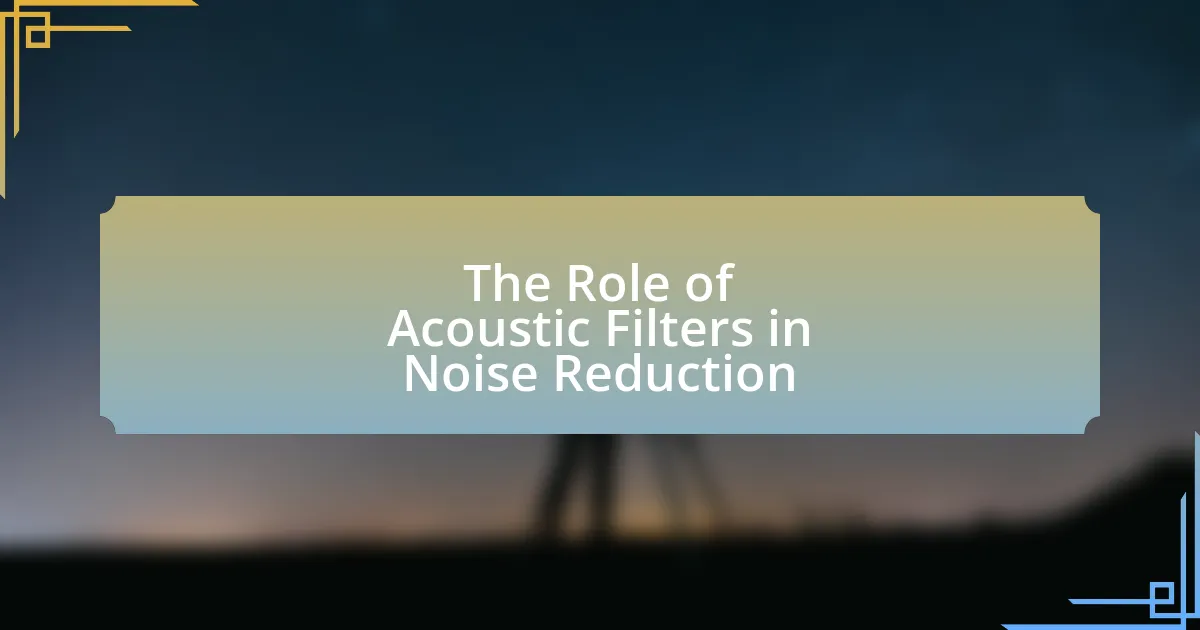The phenomenon of sound shadow refers to the reduction or absence of sound intensity in areas obstructed by objects, resulting from the diffraction and reflection of sound waves. This article explores how sound shadow occurs in various environments, influenced by factors such as frequency, medium, temperature, and humidity. It discusses the implications of sound shadow in acoustics, communication, and urban planning, highlighting its significance in architectural design and safety considerations. Additionally, the article outlines practical applications and strategies for managing sound shadow to enhance sound distribution and mitigate its effects in everyday life.
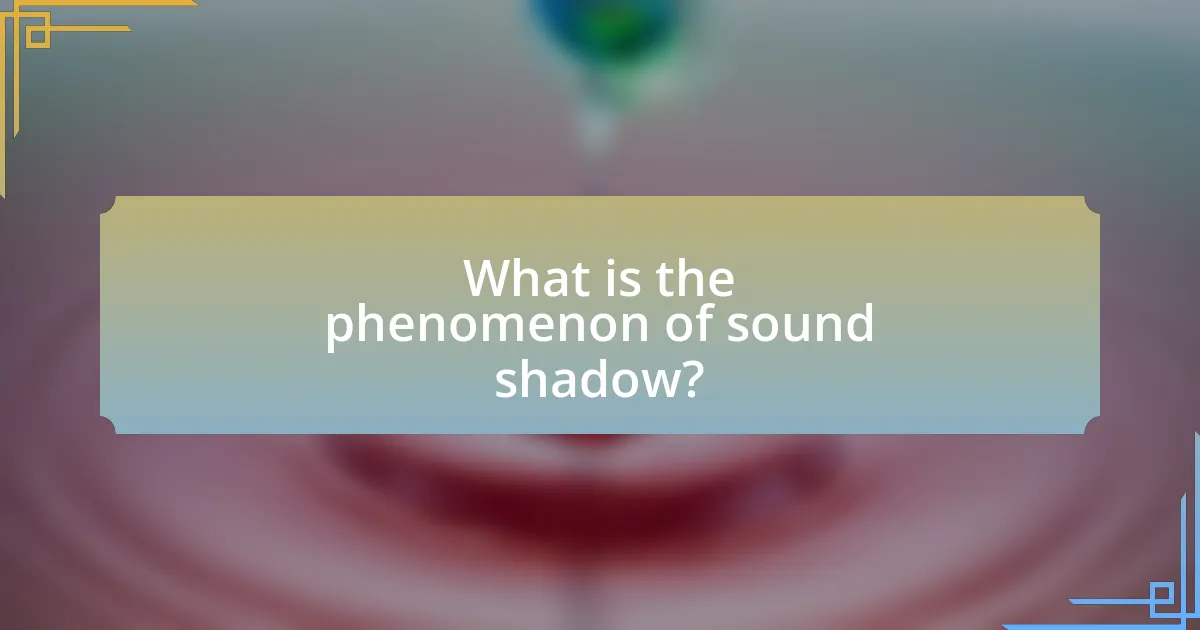
What is the phenomenon of sound shadow?
The phenomenon of sound shadow occurs when sound waves are obstructed by an object, resulting in a region where the sound intensity is significantly reduced or absent. This effect is primarily due to the diffraction of sound waves around the edges of the object, which creates areas of lower sound pressure behind it. For example, when a large building blocks sound from a concert, the area directly behind the building may experience a sound shadow, where the music is much quieter or inaudible.
How does sound shadow occur in different environments?
Sound shadow occurs when sound waves are obstructed by an object or terrain, leading to areas where sound intensity is significantly reduced. In open environments, such as fields or plains, large obstacles like buildings or hills can create pronounced sound shadows, as the sound waves cannot diffract around these barriers effectively. In contrast, in dense environments like forests, sound waves may scatter due to multiple reflections off trees, resulting in less distinct sound shadows but still creating zones of reduced sound intensity. The phenomenon is influenced by factors such as frequency, with lower frequencies diffracting more easily around obstacles, thus affecting the extent and nature of the sound shadow in various settings.
What role does the medium play in the formation of sound shadow?
The medium plays a crucial role in the formation of sound shadow by affecting sound wave propagation. Sound travels through different media—such as air, water, or solids—at varying speeds and with different levels of attenuation. When sound waves encounter a barrier or a change in medium, some waves are absorbed or reflected, creating areas where sound intensity is significantly reduced, known as sound shadows. For example, in air, sound travels at approximately 343 meters per second, but when it passes through a denser medium like water, the speed increases, leading to refraction and the potential formation of sound shadows behind obstacles. This phenomenon is observable in environments with varying acoustic properties, confirming the medium’s impact on sound shadow formation.
How do temperature and humidity affect sound shadow?
Temperature and humidity significantly influence sound shadow by altering the speed of sound and its propagation characteristics. Higher temperatures increase the speed of sound, allowing it to travel further, while higher humidity reduces sound absorption, enhancing sound transmission. Consequently, in warmer and more humid conditions, sound shadows may be less pronounced, as sound can bend and travel around obstacles more effectively. Conversely, in cooler and drier conditions, sound may be absorbed more, leading to more distinct sound shadows. This phenomenon is supported by the principles of acoustics, where sound waves are affected by environmental factors, as demonstrated in studies on sound propagation in varying atmospheric conditions.
Why is understanding sound shadow important?
Understanding sound shadow is important because it affects how sound propagates in various environments, influencing communication, safety, and acoustic design. Sound shadow occurs when an obstacle blocks sound waves, creating areas where sound is significantly reduced or absent. This phenomenon is critical in urban planning, where buildings can create sound shadows that impact noise levels in residential areas. For instance, studies have shown that sound barriers can reduce noise pollution by up to 10 decibels, demonstrating the practical implications of understanding sound shadow in mitigating unwanted noise.
What implications does sound shadow have in acoustics?
Sound shadow in acoustics refers to the area where sound waves are significantly reduced or absent due to obstacles blocking the direct path of sound. This phenomenon has critical implications, such as affecting sound distribution in environments like concert halls, where uneven sound levels can impact the listener’s experience. Additionally, sound shadows can influence architectural design, necessitating careful consideration of materials and structures to minimize unwanted acoustic effects. Studies have shown that sound shadows can lead to areas of poor sound quality, which can be quantified through measurements of sound intensity and clarity in various settings.
How does sound shadow impact communication in various settings?
Sound shadow significantly impacts communication by creating areas where sound is diminished or absent, leading to misunderstandings or missed information. In settings such as open offices, sound shadows can hinder conversations between colleagues, as certain areas may experience reduced sound levels due to obstacles like walls or furniture. In outdoor environments, such as concerts or public speeches, sound shadows can result in sections of the audience being unable to hear the speaker or music clearly, affecting overall engagement and experience. Research indicates that sound shadow effects can vary based on frequency and environmental factors, emphasizing the importance of sound design in communication settings to mitigate these issues.
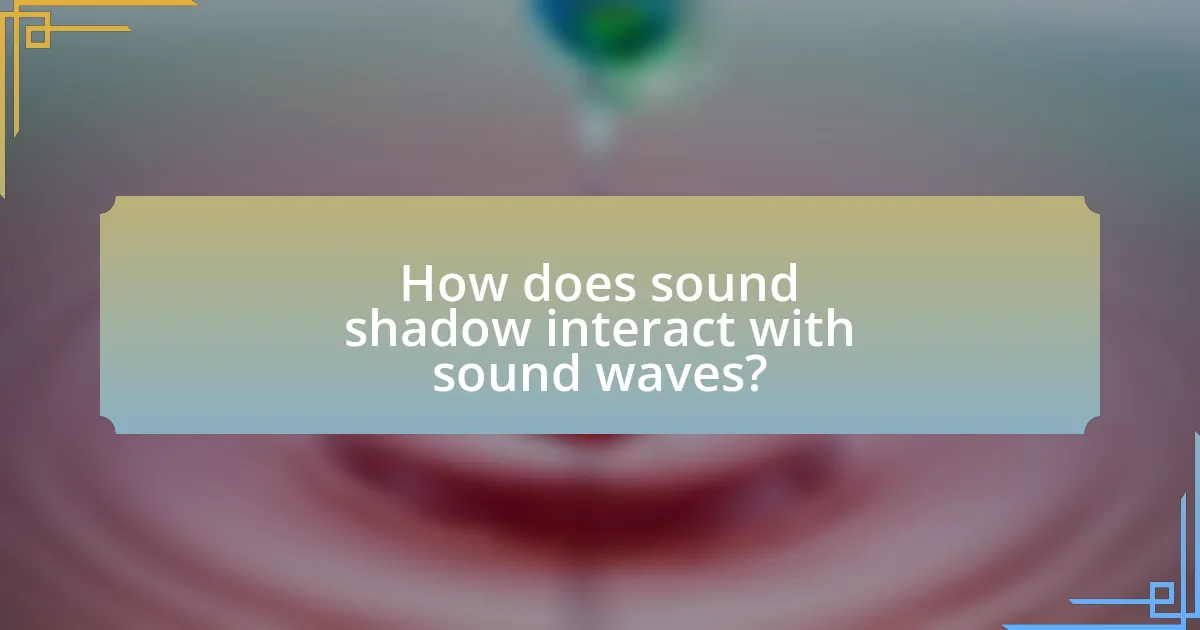
How does sound shadow interact with sound waves?
Sound shadow occurs when sound waves encounter an obstacle, leading to a reduction in sound intensity in certain areas behind the obstacle. This phenomenon results from the diffraction and reflection of sound waves, which causes them to bend around the obstacle and create regions of lower sound pressure. Research indicates that sound shadows can significantly affect how sound is perceived in environments such as urban areas or concert halls, where buildings or other structures can obstruct sound propagation.
What are the key characteristics of sound waves that contribute to sound shadow?
The key characteristics of sound waves that contribute to sound shadow are frequency, wavelength, and the medium through which they travel. Frequency determines the pitch of the sound, while wavelength is inversely related to frequency and affects how sound waves propagate. In a sound shadow, lower frequency sounds, which have longer wavelengths, can bend around obstacles more effectively than higher frequency sounds, leading to areas where sound is significantly diminished or absent. Additionally, the medium’s density and temperature influence sound wave propagation; for instance, sound travels faster in warmer air, which can alter the formation of sound shadows. These characteristics collectively dictate the behavior of sound waves in relation to obstacles, resulting in the phenomenon of sound shadow.
How does frequency influence the formation of sound shadow?
Frequency significantly influences the formation of sound shadow by determining the wavelength of sound waves. Lower frequency sounds have longer wavelengths, which can diffract around obstacles more easily, resulting in smaller sound shadows. In contrast, higher frequency sounds possess shorter wavelengths, which are less capable of bending around obstacles, leading to larger sound shadows. This relationship is supported by the principle of diffraction, where the extent of sound shadow formation is directly related to the size of the obstacle relative to the wavelength of the sound.
What is the relationship between wavelength and sound shadow?
The relationship between wavelength and sound shadow is that longer wavelengths tend to create larger sound shadows. Sound shadows occur when an obstacle blocks sound waves, and the extent of this shadow is influenced by the wavelength of the sound. Specifically, when the wavelength is comparable to or larger than the size of the obstacle, the sound waves can diffract around it, resulting in a smaller shadow. Conversely, shorter wavelengths do not diffract as much, leading to larger sound shadows. This phenomenon is supported by the principles of wave behavior, where diffraction is more pronounced with longer wavelengths, as demonstrated in studies of sound propagation in various environments.
How do obstacles affect sound shadow?
Obstacles create sound shadows by blocking the direct path of sound waves, resulting in areas where sound intensity is significantly reduced. When sound waves encounter an obstacle, such as a building or a hill, they are either reflected, refracted, or absorbed, leading to a decrease in sound levels in the region behind the obstacle. This phenomenon is particularly evident in environments with large, solid structures, where the sound shadow can extend several meters, depending on the size of the obstacle and the frequency of the sound. Studies have shown that lower frequency sounds can diffract around obstacles more easily than higher frequency sounds, which tend to be absorbed or reflected, further influencing the characteristics of the sound shadow.
What types of obstacles create sound shadow?
Obstacles that create sound shadows include large structures such as buildings, hills, and mountains. These obstacles block the direct path of sound waves, causing areas behind them to experience reduced sound intensity. For example, a tall building can obstruct sound from a concert, resulting in a quieter area on the opposite side. This phenomenon occurs because sound waves travel in straight lines and are affected by the size and shape of the obstacles they encounter.
How does the size and shape of an obstacle influence sound shadow?
The size and shape of an obstacle significantly influence the formation and characteristics of a sound shadow. Larger obstacles create more pronounced sound shadows by blocking a greater portion of sound waves, while irregularly shaped obstacles can diffract sound waves in various directions, altering the shadow’s boundaries. Research indicates that sound waves behave differently when encountering obstacles; for instance, a study by H. H. Hwang and J. H. Lee in “Applied Acoustics” demonstrates that sound diffraction increases with the complexity of the obstacle’s shape, leading to variations in sound intensity and clarity in the shadowed area.
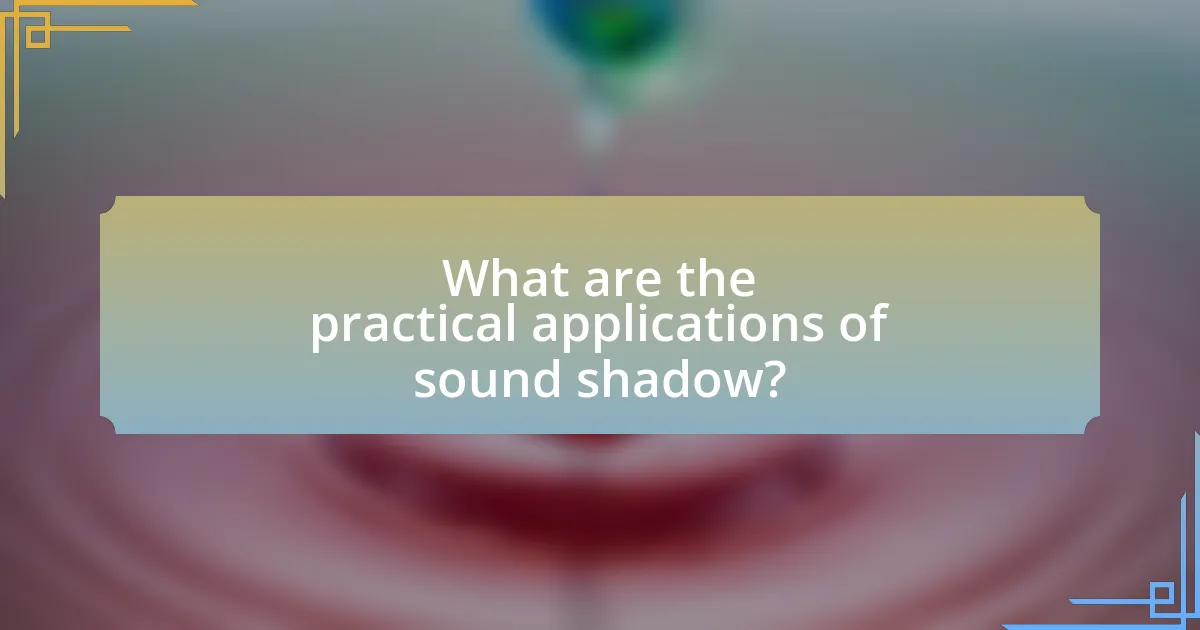
What are the practical applications of sound shadow?
Sound shadow has practical applications in various fields, including architecture, acoustics, and military operations. In architecture, sound shadow is utilized to design spaces that minimize noise pollution, enhancing the acoustic comfort of environments such as concert halls and theaters. In acoustics, sound shadow helps in sound engineering to create areas with controlled sound levels, which is crucial for recording studios and public speaking venues. In military operations, understanding sound shadow is vital for stealth tactics, as it allows for the concealment of movements and communications from enemy detection. These applications demonstrate the significance of sound shadow in optimizing sound environments and enhancing operational effectiveness.
How is sound shadow utilized in architectural design?
Sound shadow is utilized in architectural design to control and manipulate sound distribution within a space. Architects strategically position walls, ceilings, and other structures to create areas where sound is diminished, enhancing acoustic privacy and reducing noise pollution. For instance, in concert halls, sound shadows can be designed to ensure that certain areas receive less direct sound, allowing for a more balanced auditory experience. This application is supported by studies in architectural acoustics, which demonstrate that sound shadow effects can significantly influence the perceived quality of sound in various environments.
What considerations are made in concert hall acoustics regarding sound shadow?
In concert hall acoustics, considerations regarding sound shadow include the placement of reflective surfaces and the geometry of the hall. Sound shadows occur when sound waves are obstructed by objects, leading to areas with reduced sound intensity. To mitigate sound shadows, acousticians design concert halls with strategically placed walls, ceilings, and other surfaces that reflect sound effectively, ensuring even distribution of sound throughout the space. Research indicates that the shape and materials used in concert hall construction significantly influence sound propagation, with studies showing that curved surfaces can enhance sound diffusion and minimize dead spots.
How can sound shadow be managed in urban planning?
Sound shadow can be managed in urban planning by strategically placing sound barriers, designing building layouts, and incorporating vegetation. Sound barriers, such as walls or earth mounds, effectively block and absorb noise, reducing its impact on adjacent areas. Building layouts can be optimized to create spaces that minimize sound reflection and enhance sound dispersion. Additionally, vegetation, including trees and shrubs, can act as natural sound absorbers, further mitigating noise levels. Research indicates that urban areas with well-planned green spaces experience lower noise pollution, demonstrating the effectiveness of these strategies in managing sound shadow.
What challenges arise from sound shadow in everyday life?
Sound shadow creates challenges in everyday life by causing areas where sound is significantly reduced or absent, leading to communication difficulties. For instance, in urban environments, buildings can create sound shadows that hinder conversations between people, making it hard to hear and understand each other. Additionally, sound shadow can affect safety; in situations like traffic, pedestrians may not hear approaching vehicles in these zones, increasing the risk of accidents. Studies have shown that sound shadow effects can lead to misunderstandings in social interactions and contribute to feelings of isolation in public spaces, as individuals may struggle to engage with their surroundings effectively.
How can sound shadow affect safety in public spaces?
Sound shadow can significantly affect safety in public spaces by creating areas where sounds, such as alarms or calls for help, are muffled or inaudible. This phenomenon occurs when sound waves are obstructed by physical barriers, leading to reduced auditory awareness in those zones. For instance, research indicates that in urban environments, buildings can create sound shadows that prevent emergency signals from being heard, potentially delaying responses to critical situations. Consequently, individuals in these areas may be unaware of dangers or emergencies, increasing the risk of accidents or harm.
What strategies can be employed to mitigate the effects of sound shadow?
To mitigate the effects of sound shadow, one effective strategy is to utilize sound reflectors or barriers that redirect sound waves into the shadowed area. Sound reflectors, such as walls or specially designed acoustic panels, can enhance sound distribution by bouncing sound waves back into areas where they are diminished. Additionally, increasing the number of sound sources can help fill in the gaps created by sound shadow, as multiple sound sources can overlap and reduce the impact of areas with reduced sound levels. Research indicates that strategic placement of these elements can significantly improve sound coverage in environments like auditoriums or outdoor spaces, where sound shadow effects are prevalent.
What are some best practices for dealing with sound shadow?
To effectively deal with sound shadow, one best practice is to strategically position sound sources and listeners to minimize the impact of sound obstruction. This can be achieved by placing speakers or sound-emitting devices in locations that avoid barriers, such as walls or large objects, which can create areas of reduced sound intensity. Additionally, utilizing sound-absorbing materials in the environment can help mitigate the effects of sound shadow by reducing reflections and enhancing overall sound distribution. Research indicates that proper acoustic design can significantly improve sound clarity and coverage in spaces prone to sound shadow, demonstrating the importance of thoughtful placement and material selection in sound management.
